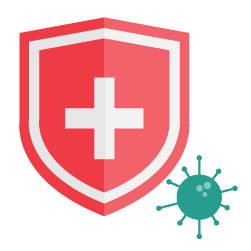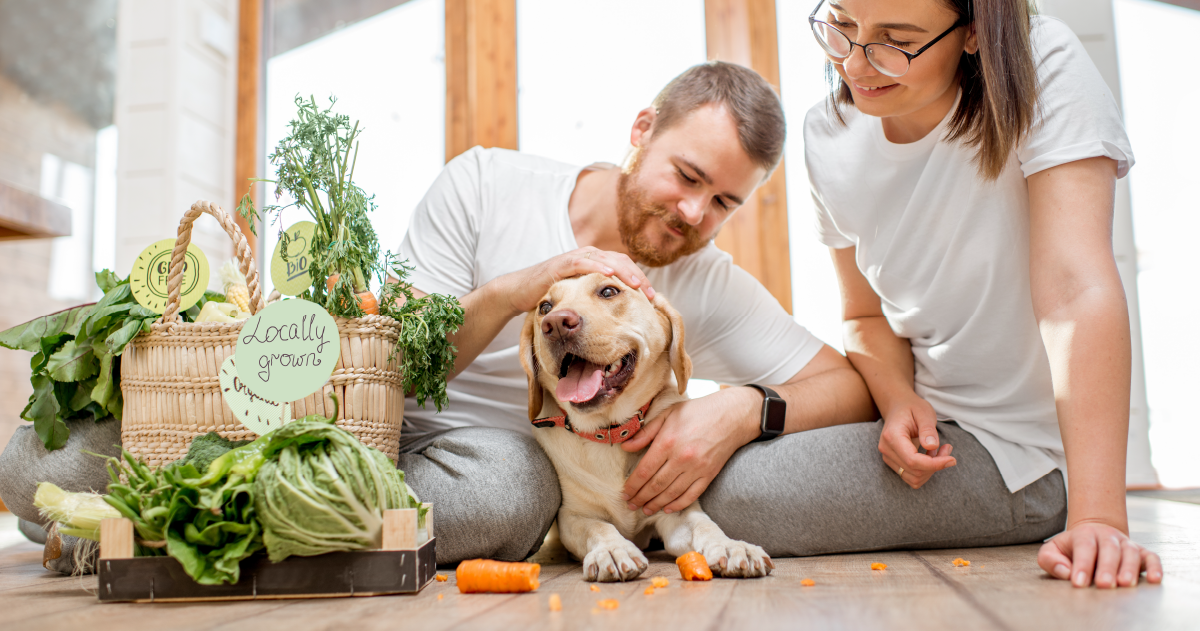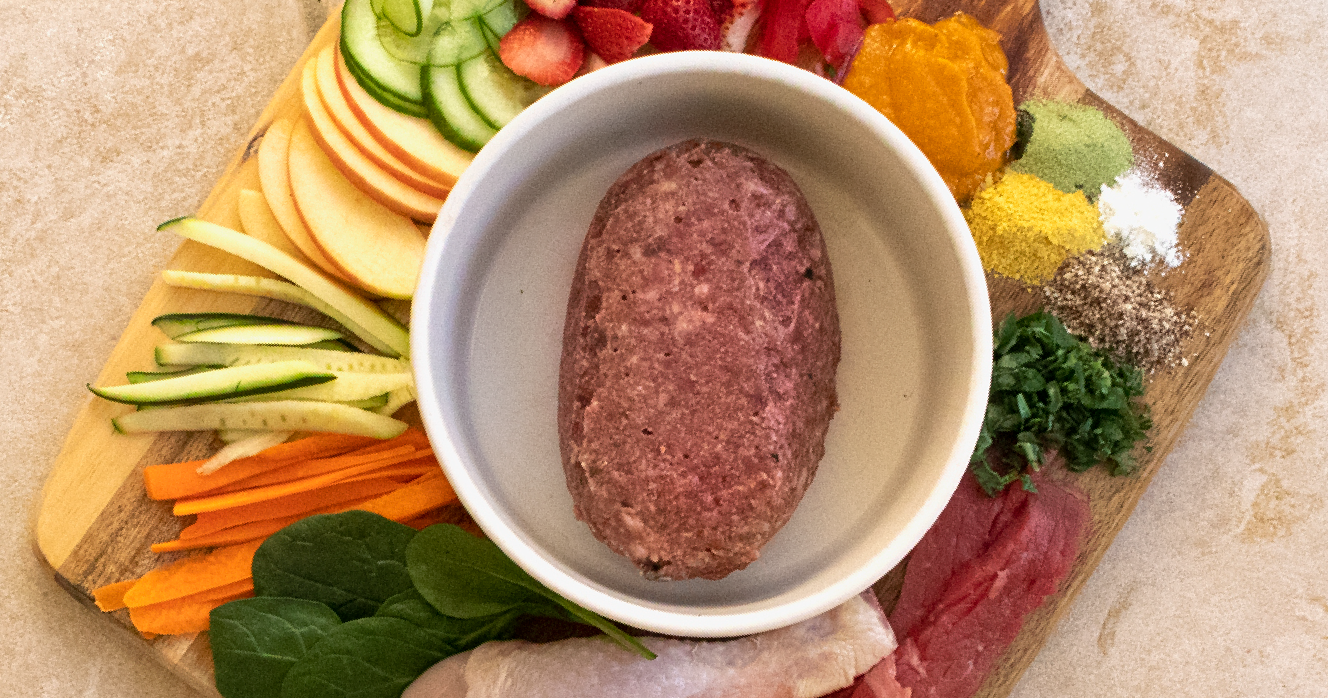Raw Feeding Rundown with Animal Nutritionist

by Narelle Cooke, Canine Nutritionist

The Benefits of Raw Food Feeding for your Dog
A healthy and balanced diet provides your dog’s body with the building blocks it needs to achieve optimal wellness. Proper nutrition throughout all life stages has been established as one of the most important factors for the prevention and management of disease, and for maintaining the long-term health and quality of life of our dogs.
Some of the benefits of feeding a more natural, species appropriate diet include:

A stronger immune system

Improved cardiovascular health

Increased cognitive ability

Lower incidence of digestive problems

Healthier coat and skin

Decreased incidence of obesity

Reduced incidence of disease and degenerative disorders
Feeding a kibble diet alone is never ideal, despite what the front of the bag might claim. Imagine how you would feel if you were told to only feed your child a highly processed cereal from a box for every meal, of every day, for their entire lives!
Cereal, like kibble, needs to have a range of different vitamins and minerals added back in to replace those lost in processing, along with preservatives to stop it going off - so in that sense it will keep us alive, but ultimately, it’s dead food. We also know that synthetic vitamins and minerals often work very differently in our bodies compared to those from natural whole food sources, and that processing destroys the beneficial enzymesthat support our dog’s digestive health and ability to fully absorb the nutrients from their food.
It is well established that eating food as close to its natural form as possible is by far our best bet for improving health and preventing disease, and it’s not just the presence of more biologically available vitamins and minerals that makes fresh foods superior. Whole foods are also important sources of 100’s of different bioactive compounds that work together synergistically to help our dogs reach their full health potential. So, whether we’re talking about our children, our dogs, or ourselves, the goal is not just to survive – we want to thrive. And while we want our dogs to live for as long as possible, we also need to ensure that they have quality of life, not just quantity.
Unfortunately, pets are now following in our footsteps in terms of the chronic health problems they’re suffering from. For example, some of the top ailments currently afflicting dogs include obesity, diabetes, autoimmune disorders, heart disease, and cancer – conditions that can often be traced back to the type of diet that the average pet dog is being fed day-in-and-day-out.

Having said all of that, it doesn’t need to be all-or-nothing for your dog to benefit. I understand that for many dog owners, feeding kibble is necessary for a variety of reasons. And when this is the case, one of the best ways to improve the quality of your dog’s diet is to add in some fresh whole foods. This should include a variety of different:
· Muscle meats. Different protein sources (i.e. chicken, lamb, beef, kangaroo, turkey, salmon, goat), will all provide different ratios of the essential amino acids and nutrients that our dogs fundamentally need.
· Organ meats. Organ meats such as liver and kidney are best considered the multivitamins of the whole food world as they’re nutrient dense and provide an array of trace minerals that play an essential role in keeping our dogs healthy.
· Plant foods. Many people overlook or even shun the idea adding plant matter to their dogs’ diets, but plants provide an amazing array of phytonutrients that our dogs can’t obtain from anywhere else. The addition of appropriate plant matter is particularly important for gut health, immune function, and cellular health. A study from Purdue University showed that dogs eating a commercial kibble that were also fed vegetables at least 3 times per week were up to 88%less likely to develop cancer than dogs that were fed kibble without any vegetables.
· Other whole foods. It’s also important (and super easy) to add in smaller amounts of foods such as eggs, fatty fish, ground seeds, turmeric, kelp, pre- and probiotics, just to name a few. These foods each have a unique nutritional profile that will benefit your dog.
In consulting with dog owners, a common sentiment that I hear is that they simply don’t know where to start when transitioning their dog to a fresh food diet, or they’re afraid that they will get it wrong. And meals that consist solely of cooked chicken, rice and vegetables is highly unbalanced and deficient in a range of essential nutrients that our dogs need for long-term health.
The most obvious one in this example is calcium. The reality is, that a large proportion of dog owners are not comfortable feeding whole raw bones to their dogs, which will ultimately lead to a calcium deficiency and an imbalance between calcium and another key mineral called phosphorus. For puppies, this type of diet will result in improper skeletal development and for adult dogs, it will make them more prone to conditions such as hip dysplasia and arthritis. A diet that consists only of chicken meat is also out of balance in regard to the omega-3 and omega-6 fatty acids. Chicken is much higher in the pro-inflammatory omega-6 fats and very low in the healthier, anti-inflammatory omega-3 fats.
As a clinical Naturopath and Nutritionist, it’s a lot easier for me to create complete and balanced meals for my own dogs and for those of my clients, but honestly, there are times when even I’m too busy to prepare meals or simply unmotivated to think about what I need to feed! And I’m sure that’s the same for most dog owners these days. Everyone is busy juggling the demands of life – work, family, household, pets – it never ends! Which is why I love that you can so easily buy balanced whole food raw patties from leading pet stores that provide our dogs with everything they need from a nutritional standpoint. Feeding commercial raw food patties takes away any of the confusion as to what to feed, as all the hard work has been done for you.
Another benefit of raw patties, particularly for extremely fussy dogs, is that everything is blended up, so they’re less likely to realise that the disliked ingredient is even in there (I’m sure there are lots of parents out there reading this who have resorted to hiding vegetables in a meat loaf or a bolognese sauce just to ensure their children eat them!).
The fact that the patties are blended also means that our dogs can get the calcium they need from actual raw bones, rather than a calcium supplement, without any of the risks that many dog owners are afraid of. As the owner of three French Bulldogs, I’m acutely aware of the anatomical challenges they face in trying to devour whole raw bones, so I’m certainly not ashamed to admit that I’ve always got a couple of boxes of Big Dog raw patties in my freezer.

Key things to look for when purchasing raw food patties for your dog include:
· Are they complete and balanced? Choosing a product that meets formal AAFCO standards gives you the peace of mind that your dog is getting everything it needs from a nutritional standpoint. However, this is not always essential if a product includes a wide variety of different muscle meats, organs, oily fish, bone and plant matter.
· Do they include artificial or synthetic additives or preservatives? For example, the Australian Veterinary Association warns that dogs can suffer fatal health problems if fed exclusively with pet mince that contains sulphur dioxide as a preservative. It has also been shown that additives that can cause a range of behavioural problems in dogs. So always choose products with real, wholefood ingredients and no nasty additives.
· Is the quality of the produce used human grade? Many pet owners may not realise that the ingredients used in many commercial dog foods are of extremely poor quality and basically consist of waste material that we, as humans, can’t consume.
· Are they grain-free? Many commercial dog foods contain high levels of biologically inappropriate carbohydrates, such as corn and soy, that our dogs are not naturally designed to eat and digest. This can contribute towards leaky gut and chronic inflammation in our dogs over time.
· Do they contain a wide assortment of different ingredients? When it comes to long term health, variety is key.
Making the transition
If you’re uncertain about making the switch to a 100% raw food diet, rest assured that you can feed raw and kibble together, and that your dog will benefit greatly from it - that’s actually how I started out with my own dogs. However, there are a few basic principles to keep in mind …
Firstly, when mixing raw with kibble, it is important to make sure that you decrease the amount of kibble being fed, so that you don’t increase the total number of calories and cause unhealthy weight gain.
Secondly, take it slowly - there’s no rush! By making changes gradually, you minimise the likelihood of stomach upsets, while at the same time helping any fussier dogs adjust to the new food. Although it varies from dog-to-dog, I generally recommend that you allow 2-4 weeks to fully transition your dog from a kibble to a raw food diet if that’s your goal. But there is still enormous benefit from feeding part kibble and part raw patties longer term.
If your dog suffers from a health condition, it is recommended that any significant dietary changes be made under the guidance of a qualified healthcare professional.
About the Author - Narelle Cooke, Canine Nutritionist.

Narelle is a clinical Naturopath, Nutritionist and Herbalist for both people and pets, and operates her wellness clinic ‘Natural Health and Nutrition’ in Dural, Sydney.
Being a lifelong dog-owner and currently meeting the demands of three French Bulldogs, two German Shepherds and a Burmese cat, Narelle is as passionate about the health and wellbeing of our pets as she is about their owners. And it was this strong desire to see her own pets live their longest and best lives that led her to hours of personal research and additional study in the area of natural animal health and nutrition.
· Bachelor of Health Science(Naturopathy) (ACNT)
· Bachelor of Agricultural Science (honours) (The University of Melbourne)
· Advanced Diploma of Naturopathy (AIAS)
· Advanced Diploma of Nutritional Medicine (AIAS)
· Advanced Diploma of Western Herbal Medicine (AIAS)
· Certificate III in Dog Behaviour and Training (NDTF)
· Certificate in Natural Animal Nutrition (CIVT)
· Certificate in Animal Nutrition (HATO)
